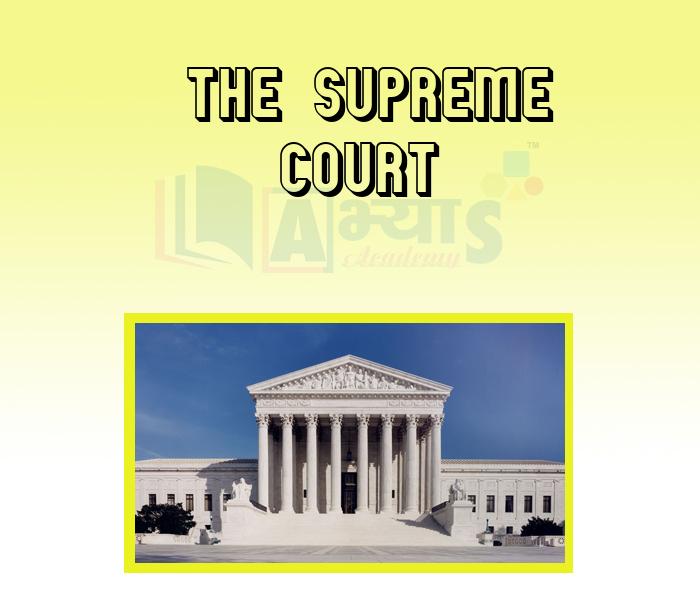The Supreme Court











The Supreme Court
The Supreme Court:
The Supreme Court of India is the highest judicial body of India and part of the land as established by Part v, Chapter IV of the Constitution of India. According to the Constitution of India, the role of the Supreme Court is that of a federal court, guardian of the Constitution and the highest court of appeal.
Articles 124 to 147 of the Constitution of India lay down the composition and jurisdiction of the Supreme Court of India. The Supreme Court is primarily the last resort and highest appellate court, which takes up appeals against judgments of the High Courts of the states and territories. But it also takes written petitions in cases of serious human right violations or if a case involves a serious issue that needs immediate resolution. The Supreme Court of India held its inaugural sitting on 28 January 1950.
The Supreme Court of India comprises the Chief Justice of India and not more than 30 other Judges appointed by the President of India. Supreme Court Judges retire upon attaining the age of 65 years. In order to be appointed as a Judge of the Supreme Court, a person must be a citizen of India and must have been, for at least five years, a Judge of a High Court or of two or more such Courts in succession, or an Advocate of a High Court or of two or more such Courts in succession for at least 10 years, or the person must be, in the opinion of the President, a distinguished jurist. Provisions exist for the appointment of a Judge of a High Court as an ad-hoc Judge of the Supreme Court and for retired Judges of the Supreme Court or High Courts to sit and act as Judges of that Court.
The Supreme Court has always maintained a wide regional representation. It also has had a good share of judges belonging to religious and ethnic minorities. The first woman to be appointed to the Supreme Court was Justice Fatima Beevi in 1987. She was later followed by Justices Sujata Manohar, Ruma Pal and Gyan Sudha Mishra.
Who is empowered to extend the jurisdiction of the Supreme Court of India in relation to any matter covered in the Union List of legislative powers ? | |||
| Right Option : C | |||
| View Explanation | |||
Who has the right to send the case going on in any court of the country ? | |||
| Right Option : B | |||
| View Explanation | |||
___________________________ of the Constitution of India lay down the composition and jurisdiction of the Supreme Court of India. | |||
| Right Option : D | |||
| View Explanation | |||
Students / Parents Reviews [10]
My experience was very good with Abhyas academy. I am studying here from 6th class and I am satisfied by its results in my life. I improved a lot here ahead of school syllabus.

Ayan Ghosh
8thIt was a good experience with Abhyas Academy. I even faced problems in starting but slowly and steadily overcomed. Especially reasoning classes helped me a lot.

Cheshta
10thBeing a parent, I saw my daughter improvement in her studies by seeing a good result in all day to day compititive exam TMO, NSO, IEO etc and as well as studies. I have got a fruitful result from my daughter.

Prisha Gupta
8thI have spent a wonderful time in Abhyas academy. It has made my reasoning more apt, English more stronger and Maths an interesting subject for me. It has given me a habbit of self studying

Yatharthi Sharma
10thIt was good as the experience because as we had come here we had been improved in a such envirnment created here.Extra is taught which is beneficial for future.

Eshan Arora
8thA marvelous experience with Abhyas. I am glad to share that my ward has achieved more than enough at the Ambala ABHYAS centre. Years have passed on and more and more he has gained. May the centre flourish and develop day by day by the grace of God.

Archit Segal
7thAbhyas Methodology is very good. It is based on according to student and each child manages accordingly to its properly. Methodology has improved the abilities of students to shine them in future.

Manish Kumar
10thMy experience with Abhyas is very good. I have learnt many things here like vedic maths and reasoning also. Teachers here first take our doubts and then there are assignments to verify our weak points.

Shivam Rana
7thAbhyas is a complete education Institute. Here extreme care is taken by teacher with the help of regular exam. Extra classes also conducted by the institute, if the student is weak.

Om Umang
10thAbout Abhyas metholodology the teachers are very nice and hardworking toward students.The Centre Head Mrs Anu Sethi is also a brilliant teacher.Abhyas has taught me how to overcome problems and has always taken my doubts and suppoeted me.
